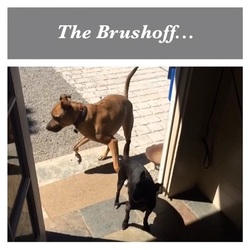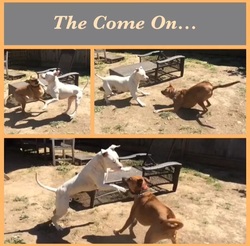
Whether you find dog-dog interaction fascinating or not, I admit that I do(!!), it is important to be able to get the gist. If you can identify when one dog is saying "back off" but the other dog isn't respecting that, you can step in. Intervening demonstrates your leadership to both dogs and if you're struggling with poor behavior in other areas, showing leadership in this context will help significantly in other areas.
These two handled things just fine on their own -- mistakes would have looked like Nala not giving Thompson his space or Thompson over correcting Nala by lunging after her. The fact that I was there may have helped their good decisions actually and please remember to always supervise socialization. Especially when there's a size difference with the dogs, a simple mistake by one dog turn into a painful and costly mishap for both.

In good quality play, dogs are practicing social skills that require reading each other and responding appropriately throughout the session. Often times dogs that haven't had a lot of good guidance and practice at playing appropriately will need help understanding boundaries and self handicapping as well as keeping their excitement level contained.
For a dog without any underlying issues, one or two corrections from either the balanced dog he is playing with or the human supervising the play quickly helps him learn successful play rules. It's pretty lovely watching well-matched dogs play... it can look like a dance performance full of balance and grace. :-)
 RSS Feed
RSS Feed